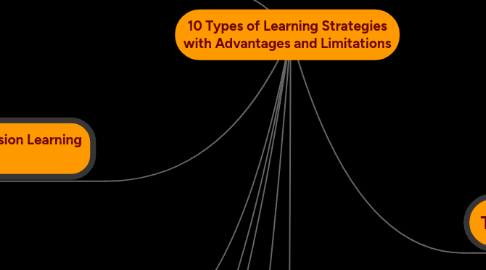
1. Student Centered
1.1. Strategies used when students are engaged with interactive activities and experiences which are guided by teachers and executed by students
2. 5- Discussion Learning Strategy
2.1. Advantages
2.1.1. 1. This can give students a way to think about what is talked about and make a connection to what they already know
2.1.1.1. 2. Discussions can be a great way for teachers and students to talk about something new.
2.2. Limitations
2.2.1. 1. A limitation would be that not all students know when or have the courage to speak up and ask questions when they have something special to share in the discussion. Teachers would have to know their students in order to know how to include everyone in the discussion.
2.2.1.1. 2. Discussions can easily be too much for some students to comprehend and fully understand.
3. 6- Cooperative Learning Strategy
3.1. Advantages
3.1.1. 1. It is important to encourage participation and accountability in activities and cooperative learning will allow students to build on this way of learning.
3.1.1.1. 2. This can encourage students to show what they have to offer and can be good for others to see how they may learn the same way.
3.2. Limitations
3.2.1. 1. This can be used when it is not needed or when students are not ready to discuss what they have learned
3.2.1.1. 2. This type of strategy requires teachers to carefully monitor to be sure all students are benefiting.
4. 7- Games Learning Strategy
4.1. Advantages
4.1.1. 1. Games are attractive to students and they can relate with it as they learn.
4.1.1.1. 2. This is a good strategy as an individual learning experience when needed or as a group activity.
4.2. Limitations
4.2.1. 1. The availability to get good educational games can be expensive and hard to get for just anyone.
4.2.1.1. 2. There can be too much competition in a game setting. Students can easily get distracted to be better than others.
5. 8- Discovery Learning Strategy
5.1. Advantages
5.1.1. 1. Learners can easily understand with deeper meaning through this approach.
5.1.1.1. 2. This can be a great experience for all levels and type of learners.
5.2. Limitations
5.2.1. 1. Preparations are needed in order for students to fully get all the benefits from the experience.
5.2.1.1. 2. Assisting all the students during this learning experience in order for students to feel confident with its usage.
6. 9- Simulations Learning Strategy
6.1. Advantages
6.1.1. 1. Simulations can be a great way for students to grasp a lesson that may be a real life experience.
6.1.1.1. 2. This could also be a great way to enact history in order for students to feel they understand the history.
6.2. Limitations
6.2.1. 1. This could be too much to comprehend in the time required.
6.2.1.1. 2. Some simulations can be too difficult to understand and may need some preparations to make it more productive for learning.
7. 10- Problem-Based Learning Strategy
7.1. Advantages
7.1.1. 1. Students can seek answers to what they have noticed in the real world and relate it to what they already know enhancing the ability to learn something more.
7.1.1.1. 2. Students can feel an involvement with the real-world.
7.2. Limitations
7.2.1. 1. It is important to collaborate with other teachers in order to find quality problems that students can benefit from.
7.2.1.1. 2. Time is always an issue when there is very little of it during the class time. Again collaborate with other teachers and find useful resources to narrow down what it is that is needed to execute a great assignment that students can learn from.
